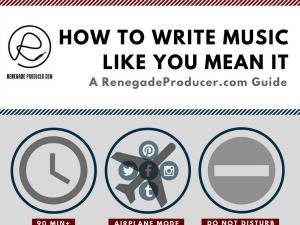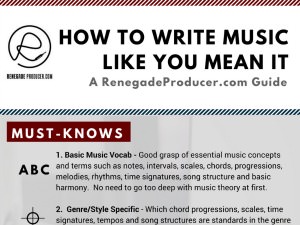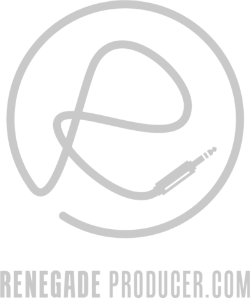25-step music production process checklist and video workshop >>>
How to Write Music Like You Mean It

This post is about how to write music like a pro. We have a look at the attitude, process, tools, skills and knowledge you want to cultivate, and use, as a newcomer serious about the craft. This is not an in-depth music theory, composition or technical post. This is more of a musing on the overall mindset and context you need to write music.
That's, of course, if you mean it!
Yes. The question is how to write music like you mean it. Like a pro.
The simple answer is: You write every day.
That's the main difference between the pro and the hobbyist. Thanks for the clarification, Mr Steven Pressfield.1
Well, that's the theory. More difficult in practice. Still. The point is to write as much as possible regardless of inspiration.
Keywords: Consistent and constant.
Now...
... as for the process...
It should be quite simple.
Here's how:
Invoke the Muse:
Fire up your lava lamps, dim your LEDs, do a little dance, burn some incense. Do whatever it takes for you to go from your everyday problem-solver-mind-state to your more playful creative mode.
Cut out all potential distractions.
“We all operate in two contrasting modes, which might be called open and closed.
The open mode is more relaxed, more receptive, more exploratory, more democratic, more playful and more humorous.
The closed mode is the tighter, more rigid, more hierarchical, more tunnel-visioned.
Most people, unfortunately spend most of their time in the closed mode. Not that the closed mode cannot be helpful. If you are leaping a ravine, the moment of takeoff is a bad time for considering alternative strategies. When you charge the enemy machine-gun post, don’t waste energy trying to see the funny side of it. Do it in the “closed” mode.
But the moment the action is over, try to return to the “open” mode—to open your mind again to all the feedback from our action that enables us to tell whether the action has been successful, or whether further action is need to improve on what we have done.
In other words, we must return to the open mode, because in that mode we are the most aware, most receptive, most creative, and therefore at our most intelligent.” – John Cleese
It takes some time to transition into play mode. Make your writing session at least 90 minutes long.
Then:Imagine the song you want to write. What type of song is it? What's the main point of the song? Choose some references and immerse yourself in them for inspiration.
Use songs, films, books, images or anything else that stimulates your creative mind to produce ideas.
Switch on your recorder or DAW. Use your favorite real or virtual instrument or sing or bang the table. Anything that makes a sound is fair game.
Start! Start with...
... a melody
... a chord progression
... a loop
... a riff
... an ambient pad or soundscape
... a line
... a title
Hit record. Try something. Anything. Doesn't work?
The Writing Process
Quick. Scrap it. Try something else.
Got it? The seed. The idea. That something that makes you go, yeah, that's something there. I can work with that. You can feel it in your nerve endings. Catch it! Save your session.
Perfect. Next, ask yourself...
"What do I need to add?" "What's next?"
Add something that's the yin to your seed idea's yang. Say the seed idea is long and smooth. Add something that is short and spiky. Contrast. Balance. Juxtapose. Work it!
Or. First add something to reinforce your seed idea. Another layer. Another line, verse, chorus or bridge. Harmonic or percussive. You decide.
All good? Nice. Onwards! Again...
Repeat this process. Always coming back to the above two questions, until...
... the answer is "nothing".
At this point you have a song. The beginnings of one at least.
Now, you can go back and craft it some more until it's ready to go out and charm the entire planet on your behalf.
That's how to write music.
Simple, right?
"Now, wait a minute!" you may think or even say out loud.
You're right to object. The above summary of how to write music may be one simplified way to look at the background decision-making process of a songwriter.
It leaves out a HUGE lot of course.
 A flow diagram of the basic thought process of songwriting. In short, keep throwing stuff at it and see what sticks.
A flow diagram of the basic thought process of songwriting. In short, keep throwing stuff at it and see what sticks.What's missing?
What's needed!
"How do I know if I got something?"
"How do I know what to add?"
"How do I know if it works or not?"
Yes, the craft of songwriting makes certain demands on you.
It requires basic songwriting knowledge, skills and habits to make the process work.
More on that further below. First, let's talk fish...
How To Write Music Like a Fisher Fishes
The music writing process seems similar to fishing in many ways:
1. A Good Fisher Knows Fish.
You must know your music. How well?
It goes without saying that the more you know about music, the better. You don't however need to develop a deep knowledge of music theory and history to write music. A basic musical vocabulary will do just fine.
 Top Tip: Find out who influenced the artists you admire. Study them carefully!
Top Tip: Find out who influenced the artists you admire. Study them carefully!Chords, chord progressions, chord inversions, notes, common scales, keys, modes, harmony, rhythm, time signatures and common music composition and arrangement terms. A firm grasp of these concepts and how use them when you write music is a must if you're serious about the craft.
Music history, genre and style: General music history, stylistic and musical differences between genres and types of music, current music production habits and techniques used by producers or artists in your genre.
Music analysis: Deconstruct and analyze songs in terms of chords, melody, rhythm, instrumentation, song structure, hooks, themes and lyrical content and form.
A fun and effective way to learn the basics of music, music history and analysis is to learn a music instrument. Guitar and piano or keyboard are great for this purpose.
Learn
to play the songs you like the most. This will over time give you
insight into a lot of the songwriting and arrangement techniques used.
2. The Fisher Knows What Type of Fish They Would Like to Catch
You know what type of music you want to write. Why? Salmon and Tuna catches need different approaches. Same goes for music. Knowing how to write music that sounds like a Skrillex screecha requires a different approach to writing an Eddie Vedder ukulele tearjerker.
Luckily, if you're reading this, you probably already know what type of music you want write. Study your genre specifically for fast progress and then slowly expand your more general songwriter vocab and toolkit.
3. Fish Don't Live in Trees
The Fisher goes to
the water. You go to your mind. You don't want fish of course, you
want ideas. Songwriting ideas can come at any time. They
seem to however more than often come in states of play rather than our
everyday problem-solving state of mind.
To go where the fish are means to make the time and space to go from the dry land of your problem-solving mind to the ocean of your creative mind. In practical terms this means setting aside at least 90 minutes of distraction-free time just to get creative. The fish live on the other side of 30 minutes.
4. No Tackle = No Fish
Trap, net, spear, hook, line and sinker. The Fisher needs his tools.

Pen, paper, mobile phone, audio recorder, musical instrument, DAW, dictionaries and other references. You need your songwriting tools.
More on this further below.
5. The Fish Get Away, Often
You don't make a good catch every time you go fishing. Every Fisher and Songwriter must develop patience and persistence.
See the Tom Petty quote.
5 Bread and Butter Songwriter Tools:
- Pen and paper for lyrics and random idea captures.
- Smart phone text notes app for lyrics and ideas. Google Keep, OneNote, EverNote are a few decent solutions.
- Smart phone voice recorder app for melodies that come at random times and voice notes. The stock recorder app works fine for this job.
- A portable recorder for when your DAW may be out of reach or inconvenient. Say I want to write out in the sun or downstairs lounge. Pull out my trusty Zoom H4N. Solved. Check out the most wished-for Portable Recorders on Amazon.com: http://amzn.to/2vlzsgU
- A Digital Audio Workstation allows you to develop your music from initial sketches into full tracks and even commercial releases.
You may already realize at this point that to write music like you mean it is a marathon, not a sprint. The songwriting game asks that you stay focused on the process in the moment. At the same time it requires patience. The type of patience that you get when you play the long game.
What does this mean in practice?
It means one has to cultivate good songwriting habits because, as the old saying goes, you become what you consistently do. Below, you'll find a few good habits to cultivate.
7 Great Songwriter Habits to Cultivate:
- Capture everything, everywhere, anytime. Keep a growing database of ideas in the cloud or on paper.
- Learn to always ask what the song needs next. Allow the current state of the song to suggest the possibilities for the next state. Try what feels right. Keep what works and discard the rest.
- Deconstruct and analyze songs in your genre and beyond. Peek under the hood to see what makes them tick in terms of lyrics, beat, music, song structure and instrumentation. Take note. Use. This habit will teach you more about how to write music than most things.
- Continue to grow your toolbox of songwriting techniques.
- Continue to expand your music theory knowledge.
- Write every day in sessions at least 90 minutes long. This is especially important when you want to come up with new ideas.
- Improve your songwriting process as you improve your music. Learn more about songwriting every day.
Knowledge & Skills
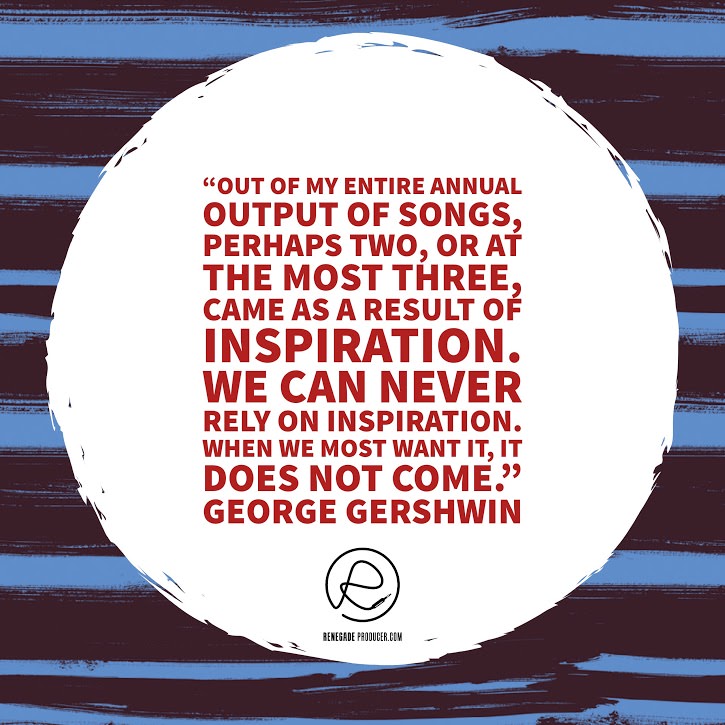
A Quick Note About Inspiration:
Inspiration comes and goes as it pleases.
We don't sit and wait for it.
We write every day.
Inspired or not.
EVERY day.
Sit down.
Write!
The Talent Thing:
Forget about it!
A: You cannot affect it.
B: The word "talent" is more often than not used in the context of an excuse.
Talent plays a small role. So small it's irrelevant in practice unless you have a ridiculous amount of talent.
That's not me. Probably not you either. Even if it was. The answer is the same:
Sit down. Write!

How to be Creative:
#1. Decide to be Creative
Done!
OK. That's not all there is to Creativity. No guarantees here.
Still, the decision to be Creative is in itself one of the most powerful things you can do to be Creative.2
Creativity is not talent. It's a set of attitudes and a way of operation.3
So, simply decide to do it and start to do it.
It may not work but then again, it might just!
“If psychologists wish to teach creativity, they likely will do better to encourage people to decide for creativity, to impress on them the joys of making this decision, and also to inoculate them for some of the challenges attendant on this decision. Deciding for creativity does not guarantee that creativity will emerge, but without the decision, it certainly will not. As a mentor, nothing makes me happier than watching at least a substantial proportion of the students I have mentored make this decision. They decide that they may pay a price but that it is a price worth paying. By making this decision, they transform both their own lives and the lives of others. What greater reward can life hold?” ~ Robert Sternberg
Learn How to Write Music, Faster - Selected Resources:
Hookpad
Hookpad is a free online music sketchpad by the folks over at Hooktheory. It allows you to create chord progressions and melodies.
It's a fun way to learn about chords, progressions and scales all in one place. It also shows you the Roman Numeral system of numbering which is pretty handy once you know it.
There is a paid version available that allows you to export your work as MIDI to use in your DAW among other options. I've not used the paid version so I cannot comment but you can still play and learn a lot with the free version.
Go play right now, here. (affiliate link)
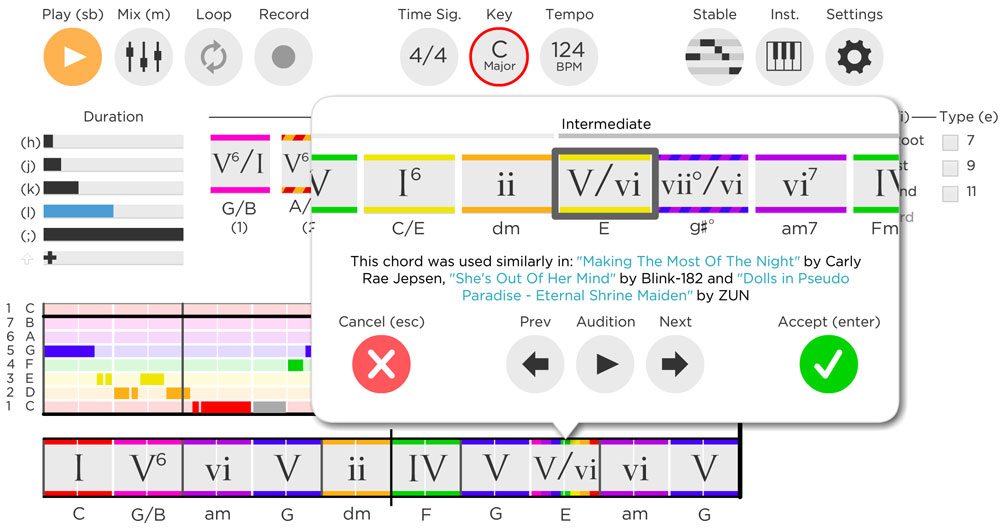
Pat Pattinson - Professor at Berklee College of Music
Professor Pattinson knows songwriting like few others and his lectures
are filled to the brim with useful advice and insights on how to write
popular music. Oh, and did I mention that a ton of his lectures are available in full, for free, on Youtube?
Do yourself a favor and binge watch this playlist below! Remember to also check out his book, mentioned below. The insights he shares on lyric-writing are especially powerful.
Music Theory for Musicians and Normal People
This collection of posters by Toby W. Rush explains the fundamentals of
music theory and does so in a novel way. It may be aimed at kids but
at least it's easier to digest than many other dry music theory books.
You can download the PDF here.
Now, Go and Bring Back Fish Dinner for the Tribe!
Start today. Write something new. Learn something new. Listen to something new.
Repeat this every day. Write. Learn. Listen. Repeat.
Find yourself bored? Up the challenge-level.
Find yourself frustrated? Up your skill-level.
You should, having read this far, have a decent idea of how to write music like you mean it. Yes, it's the big-picture overview and yes, you may still have the most of your learning ahead of you when it comes to the details of what you need to learn.
You can imagine that it's not possible for me or anyone to teach you the magical side of songwriting. I don't know if it's teachable. It seems like something which happens, sometimes, when you are at work on your craft. Sooooooooo ...
... be at work as much as possible.
I wish you tight lines and a good catch!
P.S. Watch this space for more on songwriting and creativity soon.
P.P.S. Please share this post if you like it. Thank you!
References:
1. http://amzn.to/2urHMOn Steven Pressfield, Turning Pro: Tap Your Inner Power and Create Your Life's Work
2. http://www.robertjsternberg.com/investment-theory-of-creativity/ Robert Sternberg, Investment Theory of Creativity
3. https://www.brainpickings.org/2012/04/12/john-cleese-on-creativity-1991/ John Cleese on the Five Factors to Make Your Life More Creative


Learn to understand equalisers and frequencies to supercharge your mixing skills and get results, fast...

New producer? Learn everything you need to produce your first professional track right now...
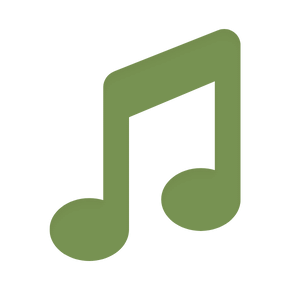
Would you like to discover the simplest and easiest way to learn music theory as a music producer?
Share this post. Spread the knowledge so other producers can benefit too:
- Renegade Producer
- Music Production
- How to Write Music
ⓘ Some pages contain affiliate links so I might earn a commission when you buy through my links. Thanks for your support! Learn more
